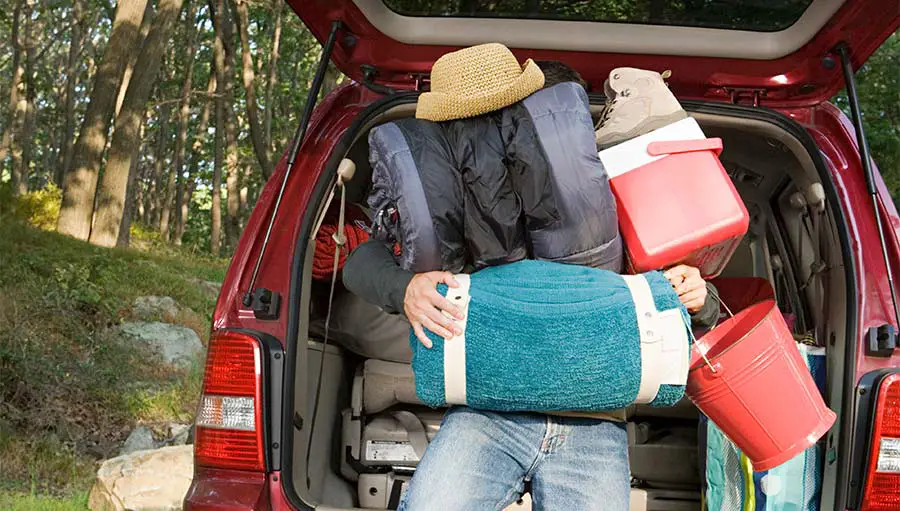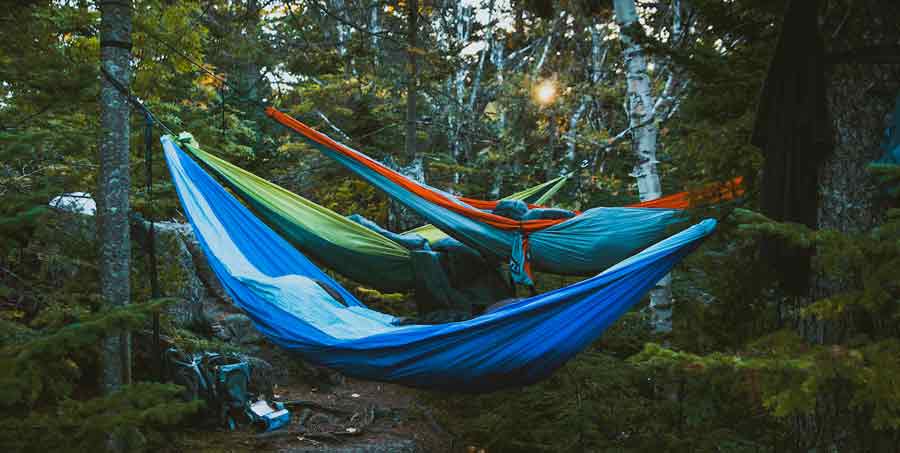Hammock Camping: Do you need a sleeping bag?
Sleeping bags? Do you need one for hammock camping? I had the very same question when I first started researching sleeping in a hammock. As I’ve said before, experience is the best teacher and often the lessons are undesirable. At one point or another, most if not all, hammock campers have endured a cold night at some point. Not fun. Believe me, I’ve done it too. I hope that by reading this post, you will come away with better information than I had and prepare more thoroughly for your trip.
So do you need a sleeping bag for hammock camping?
No, you do not need to have a sleeping bag while hammock camping. However, you do need to have some kind of protective barrier between your body and the airflow going under your hammock to keep you insulated. Even on a warm day, the convection under the hammock can make you cold. In other words, you cannot retain your body heat when you are suspended above the ground. You will need a good insulation system to keep you warm and cozy.
Usually, a sleeping bag is on everyone’s packing list for camping, but a sleeping bag isn’t always the best, or even wise, choice when it comes to hammock camping. Sure, I have used sleeping bags in my hammock, but they aren’t my go-to insulation system especially when backpacking. There are several factors to consider when determining if a sleeping bag is going to keep you warm enough.

Insulate to Stay Warm in your Hammock
The first thing that you need to understand is that you need to have some kind of insulation inside your hammock no matter the weather or outside temperature. An inexperienced hammock camper will often assume that since it is hot or warm outside, even in the overnight hours, he will be warm in his hammock. Not always true.
Your hammock material and why it matters
Camping hammocks are typically made of nylon. In other words, parachute-like material. There are different types of nylon, but for the most part, they are all the same thickness. They are also extremely durable and tear resistant. Nylon is also the ideal material for hammocks because of the breathability. Hammock manufacturers market their hammocks with the benefit of keeping you cool and comfortable.
The breathability of nylon is a double-edged sword. The downfall is that you can lose too much body heat through your hammock. There are easy solutions to this issue, but first, let’s talk about the science of hammock camping.
A little science lesson on heat loss while hammock camping
Whether you were an all-star in science class or barely passed, it’s important for all hammock campers to at least understand the ways we lose body heat. Here’s a little refresher on how we lose body heat.
Radiation is important to understand for hammock camping because we need to find ways to slow down the process. We do this by insulating our bodies with warm clothes that form an air pocket between our skin and the environment. Having that air pocket as a buffer slows down the loss of body heat and traps the heat that our body is radiating. This is how heavy down coats and sleeping bags work.
Radiation is when your body heat is released into the environment. We lose a significant amount of body heat through radiation. The percentage can be up to as high as 65% depending on what the temperature is on the outside of the body. Our bodies are usually warmer than the outside air that surrounds us in our daily lives thus a significant amount of our body heat is radiated into the environment. The warmer of two objects radiates the heat to the cooler in an attempt to reach equilibrium.
Conduction and convection are two other ways that our body loses heat. While conduction is also very important to understand, we will first talk about convection because it is most relevant to hammock camping and what people most underestimate.
Convection is similar to radiation in that your body heat is lost to the cooler air in the environment. The difference is that the cooler air is moving in currents around the object – in this case, you and your hammock are surrounded by moving air. The moving air, the wind, takes your body heat with it and moves it away more rapidly than radiation alone. You must insulate your hammock with a protective barrier against the wind.
Conduction is when an object, in this case, your body, is in direct contact with a colder object, most usually the ground if we are talking about camping. Depending on how cold the ground or surface is, you can lose body heat fast. When tent camping, it’s important to also insulate yourself from the colder ground.
Lower Body Temperature While Sleeping
As hammock campers, we also need to be aware of the body just doing its thing. What I mean by this is when you sleep, your body does a lot of maintenance work and is re-charging itself. One of the things the body does to conserve energy while it’s busy recharging, detoxing, and repairing itself is it lowers the body temperature. The entire body system slows down – heart rate and blood pressure become lower and it is harder to regulate body temperature. This just increases the potential for loss of body heat and another reason that you need to ensure that your hammock is well insulated.
How sleeping bags work to keep you warm
Remember how our bodies radiate heat into the environment? A sleeping bag works by capturing the heat naturally radiating from your body. The small enclosed space within the sleeping bag creates an air pocket that is quickly warmed by your body heat. Sleeping bags are designed to capture and efficiently contain heat. The outer shell of the sleeping bag keeps moisture out and the insulation fill inside the bag works to keep the occupant nice and toasty warm.
Thickness and temperature ratings
The thickness, or loft, of a sleeping bag is what will determine the amount of warmth it will provide. The thicker the sleeping bag, the better it will hold in and trap the heat. However, a thick sleeping bag may not be an option for backpackers who are looking to keep their load as light as possible. Backpackers who wish to hammock camp may have to find an alternative lighter weight insulation system.
The comfort and lower-limit ratings will have a lot to do with how warm a particular sleeping bag will keep you. You will want to make sure you have the proper temperature rating when you are choosing a sleeping bag. Also, keep in mind that not all ratings are created equally and could differ between manufacturers.
Other factors that are completely dependent on your individual situation will also have to be considered. Things like your natural metabolism while you sleep, the clothes you wear, other insulation methods, outside temperatures, and wind to name a few.
If you are going to be using your sleeping bag in variable temperatures and want to get the most bang for your buck, I recommend getting a bag with a lower temperature rating. This will allow you to use the same bag for most, if not all, the seasons.

Synthetic or Natural Fill
There are definitely some pros and cons to each type of insulation fill when it comes to sleeping bags. Your needs will determine the type of fill you choose.
Synthetic
Synthetic fill is the way to go if you are looking for a more cost-effective option to down fill. Allergies to down may also be why someone would turn to a man-made fiber since those materials are usually hypoallergenic. Those interested in cruelty-free products may also opt for synthetic fill.
A sleeping bag made with synthetic fibers will also resist water more readily than down and will keep you warm even if the bag gets wet. A bonus is that if your sleeping bag does get wet, the synthetic materials don’t absorb water and it dries quickly.
Synthetic fill also takes much less care and maintenance than natural fibers. Usually, these types of materials can be popped into the washing machine and then stored away without much thought. However, these materials break down faster over time and won’t last as long as a natural fill.
You may choose to go with a natural fill such as down if you are looking for a light-weight, less bulky sleeping bag. Manufacturers of synthetics haven’t quite been able to duplicate the lighter-weight, more compact properties that down offers.
Synthetic manufacturers are always coming up with new and improved technology. There are many brands of synthetic sleeping bag materials, all with differing technologies and fiber types, out on the market as we speak.
PROS
- Doesn’t absorb water
- Dries quickly
- Provides warmth even if it’s wet
- The material is firm and resilient
- Insulates well under a person’s weight
- Machine washable
CONS
- Doesn’t compress as much as natural fibers
- Heavier
- Takes up more space
- Material breaks down faster than natural fibers
Natural
While there are other natural fills such as wool and cotton, the focus will be down since it is the most commonly used natural fill for sleeping bags.
Down is more expensive than it’s synthetic counterparts, but it will also last a lot longer with proper care. The key is to invest in a high-quality down fill. There are low quality down fills as well that could cause potential problems so do your research ahead of time.
So far, nothing compares to down when it comes to its light-weight nature and the warmth it provides. Down compresses well and would be a good option for backpackers and those looking for more portable sleeping bag options.
Water is the greatest concern when it comes to down as it retains water and doesn’t dry quickly. If a down filled sleeping bag gets wet, it will not keep you warm. You would actually be better off to sleep without a sleeping bag than to sleep in a bag with wet down.
As mentioned above, a down filled sleeping bag will last for many years – if you care for it properly. It’s higher maintenance, but many find that it is worth it.
PROS
- Weighs less than synthetic fills
- Retains heat well
- Compresses well for storage
CONS
- Retains water easily
- Usually expensive
- Will not provide warmth when wet
- Does not dry quickly
- High maintenance
A Sleeping Bag Isn’t Always the Best Insulator
Now that we have talked about why having an insulation system is crucial, the science of body heat loss, and how a sleeping bag works, we can determine if a sleeping bag is a good choice for insulation.
The answer is, sometimes. My boys and I have successfully used only our sleeping bags as insulation in our hammocks on several occasions. However, others in the community are strongly against using sleeping bags and feel they are useless.
You do need to be aware of the fact that using a sleeping bag inside your hammock is a little restricting and hard to use. I don’t usually zip my bag up and use it more as a blanket inside my hammock in combination with my sleeping pad. If you need to zip your sleeping bag to capture more heat, you may find yourself feeling trapped. If you have any issues with tight spaces, I wouldn’t recommend zipping up your sleeping bag while in your hammock.
Sleeping bags are certainly budget-friendly. Well…if you go the synthetic fill route. Just about every person you know probably has multiples hanging out in their garage. You can even get a little creative with how you use the sleeping bag with your hammock – hint – you don’t sleep inside it. Don’t be afraid to experiment and combine other insulation methods with your sleeping bag.
Keep in mind that factors such as the outdoor temperatures, the comfort and lower-limit rating of the sleeping bag, and the weight of the person matters. Why the weight of the person? Because of compression. If the sleeping bag is compressed into the hammock, it won’t provide enough protection against heat loss.
If you don’t feel that a sleeping bag is the right fit for you, and you need to find another insulation system for your hammock, I compiled a list of sleeping bag alternatives in another post.
All in all, a sleeping bag may not fit the needs of every hammock camper, but it can still be a good option for some. I’m definitely not against using sleeping bags in my hammock especially if I am not backpacking and camping near my car. My boys love using their sleeping bags in their hammocks and burrow deep into them in the night – so much so I usually have to dig them out in the morning. There’s always a significant amount of heat that comes out of their little cocoons when I open the end of the sleeping bags.
No matter what insulation system you choose just be sure it is going to keep you cozy and comfortable in The Wanderful Wild.
